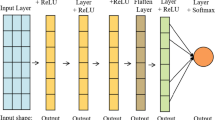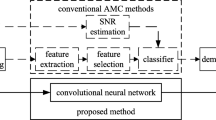Abstract
Determining the type of modulation is an important task in military communications, satellite communications systems, and submarine communications. In this study, a new digital modulation classification model is presented for detecting various types of modulated signals. The continuous wavelet transform is used in the first step to create a visual representation of the spectral density of the frequencies of the modulation signals in a scalogram image. The subsequent stage involves the utilization of a deep convolutional neural network for feature extraction from the scalogram images. In the next step, the best features are chosen using the MRMR algorithm. MRMR algorithm increases the classification speed and the ability of interpret the classification model by reducing the dimensions of the features. In the fourth step, the modulations are classified using the group learning technique. In the simulations, modulated signals with different amounts of noise with SNR from 0 to 25 dB are considered. Then, accuracy, precision, recall, and F1-score are used to evaluate the performance of the proposed method. The results of the simulations prove that the proposed model with achieving above 99.9% accuracy performs well in the presence of different amounts of noise and provides better performance than other previous studies.









Similar content being viewed by others
Data availability
Data sharing not applicable to this article as no datasets were generated or analyzed during the current study.
References
Wei S, Sun Z, Wang Z et al (2023) An efficient data augmentation method for automatic modulation recognition from low-data imbalanced-class regime. Appl Sci 13:3177. https://doi.org/10.3390/app13053177
Zhang D, Lu Y, Li Y et al (2023) Frequency learning attention networks based on deep learning for automatic modulation classification in wireless communication. Pattern Recognit 137:109345
Jdid B, Hassan K, Dayoub I et al (2021) Machine learning based automatic modulation recognition for wireless communications: a comprehensive survey. IEEE Access 9:57851–57873. https://doi.org/10.1109/ACCESS.2021.3071801
Chen W, Xie Z, Ma L et al (2019) A faster maximum-likelihood modulation classification in flat fading non-Gaussian channels. IEEE Commun Lett 23:454–457
Krayani A, Alam AS, Calipari M et al (2021) Automatic modulation classification in cognitive-IoT radios using generalized dynamic Bayesian networks. In: 7th IEEE world forum internet things WF-IoT 2021 pp 235–240https://doi.org/10.1109/WF-IoT51360.2021.9594936
Urriza P, Rebeiz E, Pawelczak P, Cabric D (2011) Computationally efficient modulation level classification based on probability distribution distance functions. IEEE Commun Lett 15:476–478. https://doi.org/10.1109/LCOMM.2011.032811.110316
Ismael MR, Abd HJ, Gatte MT (2022) Recognition of APSK digital modulation signal based on wavelet scattering transform. In: Lecture Notes in Networks and Systems. Springer, pp 469–478
Wu X, Lu L, Jiang M (2023) Deep learning aided cyclostationary feature analysis for blind modulation recognition in massive MIMO systems. Digit Signal Process 134:103890
Tan X, Xie Z, Yuan X, et al (2022) Small sample signal modulation recognition based on higher-order Cumulants and CatBoost. In: Proceedings—2022 7th international conference on communication, image and signal processing, CCISP 2022. IEEE, pp 324–329
Liu Y, Liu Y (2020) Modulation recognition with pre-denoising convolutional neural network. Electron Lett 56:255–257. https://doi.org/10.1049/el.2019.3586
Ghasemzadeh P (2023) A novel graph neural network-based framework for automatic modulation classification in mobile environments
Salama AA, Morsy ME, Darwish SH, Mohamed EI (2022) A novel SVM-based automatic modulation classifier. Int Telecommun Conf ITC-Egypt 2022—Proc. https://doi.org/10.1109/ITC-Egypt55520.2022.9855683
Sun X, Su S, Zuo Z, Guo X, Tan X (2020) Modulation classification using compressed sensing and decision tree–support vector machine in cognitive radio system. Sensors 20(5):1438. https://doi.org/10.3390/s20051438
Alhadi BA, Hasan TM, Hamed HA (2020) Digitally modulated signal recognition based on feature extraction optimization and random forest classifier. In: New trends in information and communications technology applications: 4th international conference, NTICT 2020, Baghdad, Iraq, Proceedings 4. Springer, pp 75–84
Li Y, Hong G, Feng C (2022) Application and effectiveness of weighted KNN in pattern recognition of communication modulated signals. In: 2022 IEEE 4th international conference on civil aviation safety and information technology (ICCASIT). IEEE, pp 744–748
Kamble A, Ghare PH, Kumar V (2022) Deep-learning-based BCI for automatic imagined speech recognition using SPWVD. IEEE Trans Instrum Meas 72:1–10
Peng S, Cao L, Zhou Y et al (2022) A survey on deep learning for textual emotion analysis in social networks. Digit Commun Netw 8:745–762
Lingxin Z, Junkai S, Baijie Z (2022) A review of the research and application of deep learning-based computer vision in structural damage detection. Earthq Eng Eng Vib 21:1–21
Tayakout H, Boutellaa E, Bouchibane FZ (2022) On the robustness of digital modulation recognition for cooperative relaying networks under imperfect CSI. In: 2022 7th international conference on image and signal processing and their applications (ISPA). IEEE, pp 1–6
Nguyen CT, Van Huynh N, Chu NH, et al (2022) Transfer learning for wireless networks: a comprehensive survey. Proc IEEE
Wang Z, Wang P, Lan P (2022) Automatic modulation classification based on CNN, LSTM and attention mechanism. In: 2022 IEEE 8th international conference on computer and communications (ICCC). IEEE, pp 105–110
Wang Y, Fang S, Fan Y, Wang Z (2023) A CLSTM network algorithm for automatic modulation recognition. In: International conference on signal processing, computer networks, and communications (SPCNC 2022). SPIE, pp 456–462
Chakravarty N, Dua M, Dua S (2023) Automatic modulation classification using amalgam CNN-LSTM. In: 2023 IEEE radio and antenna days of the Indian Ocean (RADIO). IEEE, pp 1–2
Hanna S, Dick C, Cabric D (2022) Signal processing-based deep learning for blind symbol decoding and modulation classification. IEEE J Sel Areas Commun 40:82–96. https://doi.org/10.1109/JSAC.2021.3126088
Ghasemzadeh P, Hempel M, Sharif H (2022) A robust graph convolutional neural network-based classifier for automatic modulation recognition. In: 2022 international wireless communications and mobile computing (IWCMC). IEEE, pp 907–912
Hou C, Liu G, Tian Q et al (2022) Multi-signal modulation classification using sliding window detection and complex convolutional network in frequency domain. IEEE Internet Things J 9:19438–19449. https://doi.org/10.1109/JIOT.2022.3167107
Liao K, Zhao Y, Gu J et al (2021) Sequential convolutional recurrent neural networks for fast automatic modulation classification. IEEE Access 9:27182–27188. https://doi.org/10.1109/ACCESS.2021.3053427
Huang S, Dai R, Huang J et al (2020) Automatic modulation classification using gated recurrent residual network. IEEE Internet Things J 7:7795–7807
Utrilla R, Fonseca E, Araujo A, Dasilva LA (2020) Gated recurrent unit neural networks for automatic modulation classification with resource-constrained end-devices. IEEE Access 8:112783–112794. https://doi.org/10.1109/ACCESS.2020.3002770
Zhou Q, Jing X, He Y, et al (2020) LSTM-based automatic modulation classification. In: 2020 IEEE international symposium on broadband multimedia systems and broadcasting (BMSB). IEEE, pp 1–4
Li Y, Shao G, Wang B (2019) Automatic modulation classification based on bispectrum and CNN. In: 2019 IEEE 8th joint international information technology and artificial intelligence conference (ITAIC). IEEE, pp 311–316
Patel M, Wang X, Mao S (2020) Data augmentation with conditional GAN for automatic modulation classification. WiseML 2020 - Proc 2nd ACM Work Wirel Secur Mach Learn 31–36. https://doi.org/10.1145/3395352.3402622
Jagannath A, Jagannath J (2021) Multi-task learning approach for automatic modulation and wireless signal classification. IEEE Int Conf Commun. https://doi.org/10.1109/ICC42927.2021.9500447
Hou C, Li Y, Chen X, Zhang J (2021) Automatic modulation classification using KELM with joint features of CNN and LBP. Phys Commun 45:101259. https://doi.org/10.1016/j.phycom.2020.101259
Shah AH, Miry AH, Salman TM (2023) Automatic modulation classification based deep learning with mixed feature. Int J Electr Comput Eng 13:1647–1653. https://doi.org/10.11591/ijece.v13i2.pp1647-1653
Fu X, Gui G, Wang Y et al (2022) Automatic modulation classification based on decentralized learning and ensemble learning. IEEE Trans Veh Technol 71:7942–7946. https://doi.org/10.1109/TVT.2022.3164935
Anandkumar D, Sangeetha RG (2021) A survey on performance enhancement in free space optical communication system through channel models and modulation techniques. Springer, US
Nambisan A, Gajjar V, Kosbar K (2022) Scalogram aided automatic modulation classification. International foundation for telemetering
Almanza-Conejo O, Almanza-Ojeda DL, Contreras-Hernandez JL, Ibarra-Manzano MA (2023) Emotion recognition in EEG signals using the continuous wavelet transform and CNNs. Neural Comput Appl 35:1409–1422. https://doi.org/10.1007/s00521-022-07843-9
Ghanem HS, Shoaib MR, El-Gazar S et al (2022) Automatic modulation classification with 2D transforms and convolutional neural network. Trans Emerg Telecommun Technol 33:e4623
Mirzaei B, Nikpour B, Nezamabadi-pour H (2021) CDBH: a clustering and density-based hybrid approach for imbalanced data classification. Exp Syst Appl 164:114035. https://doi.org/10.1016/j.eswa.2020.114035
Mirzaei B, Rahmati F, Nezamabadi-pour H (2022) A score-based preprocessing technique for class imbalance problems. Pattern Anal Appl 25:913–931
Pinto-Orellana MA, Hammer HL (2020) Dyadic aggregated autoregressive model (DASAR) for automatic modulation classification. IEEE Access 8:156096–156103. https://doi.org/10.1109/ACCESS.2020.3019243
Lin R, Ren W, Sun X et al (2020) A hybrid neural network for fast automatic modulation classification. IEEE Access 8:130314–130322. https://doi.org/10.1109/ACCESS.2020.3009471
Mohsen S, Ali AM, Emam A (2023) Automatic modulation recognition using CNN deep learning models. Multimed Tools Appl. https://doi.org/10.1007/s11042-023-15814-y
Liu K, Li F (2023) Automatic modulation recognition based on a multiscale network with statistical features. Phys Commun 58:102052. https://doi.org/10.1016/j.phycom.2023.102052
Qian L, Wu H, Zhang T, Yang X (2023) Research and implementation of modulation recognition based on cascaded feature fusion. IET Commun 17:1037–1047. https://doi.org/10.1049/cmu2.12604
Kumar A, Srinivas KK, Majhi S (2023) Automatic modulation classification for adaptive OFDM systems using convolutional neural networks with residual learning. IEEE Access 11:61013–61024. https://doi.org/10.1109/ACCESS.2023.3286939
Lee S, Il YY, Jung YJ (2023) Generative adversarial network-based signal inpainting for automatic modulation classification. IEEE Access 11:50431–50446. https://doi.org/10.1109/ACCESS.2023.3279022
Author information
Authors and Affiliations
Contributions
ZHO helped in conceptualization, methodology, software, validation, formal analysis, investigation, resources, data curation, writing—original draft preparation, and visualization. BM helped in conceptualization, methodology, validation, formal analysis, investigation, data curation, writing—original draft preparation, and visualization. AD helped in conceptualization, methodology, validation, formal analysis, investigation, data curation, writing—original draft preparation, and visualization.
Corresponding author
Ethics declarations
Conflict of interest
The authors declare that they have no known competing financial interests or personal relationships that could have appeared to influence the work reported in this paper.
Additional information
Publisher's Note
Springer Nature remains neutral with regard to jurisdictional claims in published maps and institutional affiliations.
Rights and permissions
Springer Nature or its licensor (e.g. a society or other partner) holds exclusive rights to this article under a publishing agreement with the author(s) or other rightsholder(s); author self-archiving of the accepted manuscript version of this article is solely governed by the terms of such publishing agreement and applicable law.
About this article
Cite this article
Hazim Obaid, Z., Mirzaei, B. & Darroudi, A. An efficient automatic modulation recognition using time–frequency information based on hybrid deep learning and bagging approach. Knowl Inf Syst 66, 2607–2624 (2024). https://doi.org/10.1007/s10115-023-02041-y
Received:
Revised:
Accepted:
Published:
Issue Date:
DOI: https://doi.org/10.1007/s10115-023-02041-y




